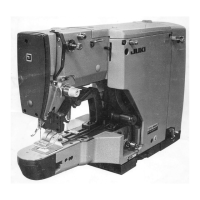II.
MEASURES
TO
ELIMINATE
STITCHING
FAILURES
This chapter
covers
stitching
failures
and their corrective
measures,
e.g.thread
escape,
thread
breakage,
stitch-skipping,
needle breakage, thread trimmer failure and related problems.
(1) Thread escape
Phenomenon The machine fails to form the first, secondor third stitches and the thread slipsout of the
needle eye.
Possiblecauses ^The first stitch was skipped.
•The
thread left in the needle eye before starting was too short.
•The
thread take-up spring was
not
properly adjusted.
•The
bobbin
thread
was
too
short.
Corrective
measures
1) To preventthe first stitch from
being
skipped
A. Check
the
relative position
of
the
shuttle
to
the
needle.
Readjust it,
if
necessary.
B.
Correct
the
clearance
between
the
needle
and
the
shuttle. Set the shuttle race free by loosening the
setscrew.
Reduce
the
clearance
to
0.05
to
0.1
mm
by tuming the shuttle race adjusting shaft. Take
care not to make the clearance smaller than stipu
lated,
or
the
two may touch, which would cause
wear. (Fig. 16)
C. Allow the shuttle to rotate smoothly.
Provide the shuttle with a lapping finish so
that
it
rotates smoothly in the shuttle race. Thoroughly
clean
the
inside
surface
of
the
shuttle
race
and
remove
all
fibrous
dust
and
lints.
D. Prevent the material under the work clamp foot
from fluttering. A special set
of
work clamp com
ponents by which the material can be securely
clamped
in a "U" shape (as shown in Fig. 17)
preventsthe material from fluttering whilestitching.
Large-size bar tacking components designed for knit
goods are available;
Feed
plate B2519-280-00B
Work clamp foot (right) B2551-280-00B
Workclamp foot (left) B2552-280-00B
E. Check if the feed cam is synchronized with the
needle.
When the needle starts stitching the material, the
feed cam must stop feeding the material.
If the needle is carried away by the material, you
must loosen the feed cam positioningpin and adjust
the feed cam timing. After adjusting the feed cam,
correct the positions of the stop-motion regulating
cam and the tension release link tripping segment
accordingly. (Fig. 18)
-
13
Cam
fixing
nut
Setscrew
Shuttle
race
adjusting
shaft
1
Fig.
16
Material
Work
clamp
foot
Feed
plate
Tension
release
link
tripping
segment
Feed cam positioning pin
at>
Fig. 17
Stop-motion
regulating
cam
First
stitch
positioning
hole
Fig. 18

